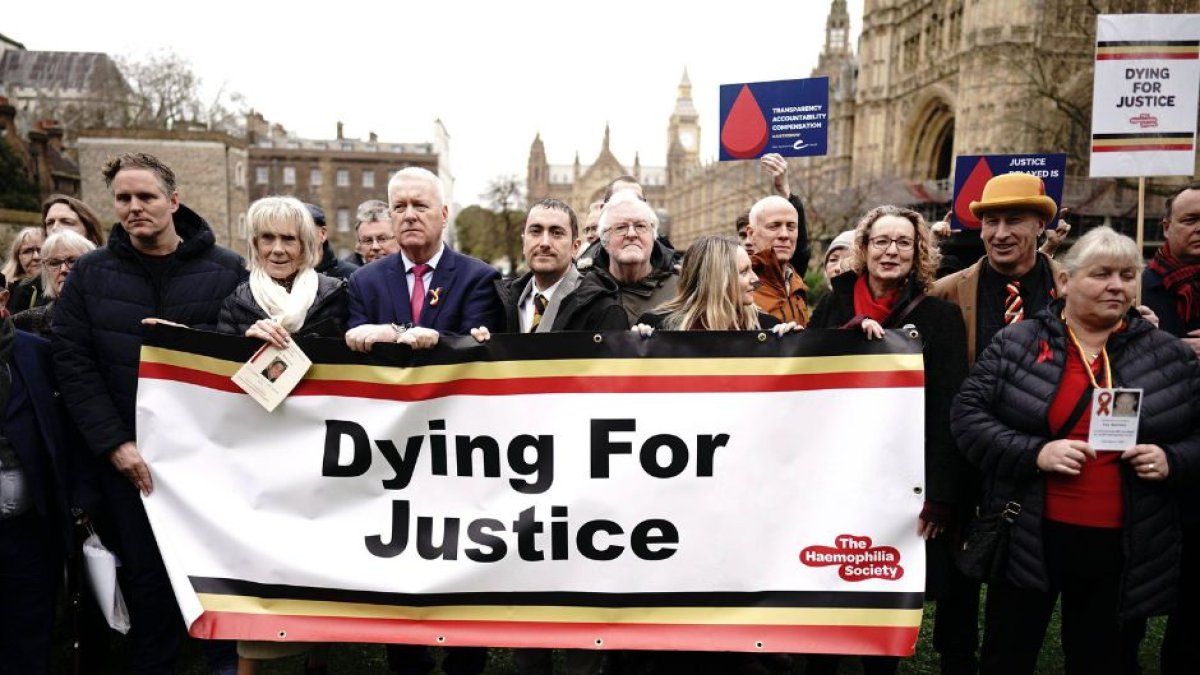Nearly 50 years of impunity with 30,000 infected with HIV and Hepatitis C: What you need to know about the UK infected blood scandal
The case dates back to the 1970s and 1980s, when some pharmaceutical companies marketed a treatment for hemophilia, knowing that it could be dangerous.

Cordon Press
In mid-May, a public inquiry will shed light on what the BBC called “the biggest treatment disaster in the history of the UK’s National Health Service (NHS).” It is a famous medical incident dating back to the 1970s and 1980s, which left thousands dead and tens of thousands infected with HIV and hepatitis C in what is popularly known as the ‘infected blood scandal.’
The public and independent investigation into what happened began in July 2018 and was led by the Infected Bloody Inquiry, chaired by Sir Brian Langstaff, who has had the support of lawyers, public officials, and investigators to provide an answer to the case.
According to the investigation’s website, millions of documents have been examined since then, and testimonies from dozens of witnesses have been heard. This process is expected to culminate on May 20, when the final report is expected to be published.
What is the UK infected blood case about?
The pharmaceutical scandal dates back to the mid-1970s when the United Kingdom began to have problems meeting the demand for treatments for people whose blood did not clot properly (such as hemophilia ), so it decided to import supplies from the United States. For example, those with hemophilia type A have a shortage of a clotting agent known as factor VIII, while those with hemophilia B do not have enough factor IX.
A new type of factor VIII had been developed at that time, thanks to the combination of plasma from tens of thousands of donors. This is precisely where the problem began. It turns out that many of the donors were high-risk, such as prisoners and drug users, which increased the chance of contaminating everything. If one of the people who donated their blood was contaminated with someone sick, the entire lot would be.
The mixture produced entire batches of products to replace Factor VIII and IX contaminated with deadly viruses, such as hepatitis C and HIV.
As a result, although the total number of infected is not known for sure, due in part to the fact that the symptoms of these diseases can take years to appear, it is estimated that approximately 30,000 people were affected by these contaminated batches. In turn, some 2,900 people have already lost their lives as a consequence.
Survivors and their families have been seeking justice ever since, so the investigation Langstaff is leading could be pivotal for them.
The role of pharmaceutical companies
As reported by The Telegraph, the final report on May 20 would reveal that the pharmaceutical companies knew that the batches used to combat hemophilia were contaminated with lethal diseases. At the time, the British Government insisted that there was “no conclusive evidence” that HIV could be transmitted through blood.
“In December 1982, Bayer’s Cutter Laboratories discovered chimpanzees had developed AIDS-like symptoms after also being treated with Factor VIII, according to an internal memo. However, the company didn’t warn patients about the potential risks. As the dangers became clear, Bayer kept selling Factor VIII. Having created a safer, heat-treated version without viruses in February 1984, Bayer continued to sell the HIV and hepatitis C-contaminated Factor VIII until August 1985. The UK kept prescribing the dangerous version of Factor VIII until late 1985, and it never recalled it from hospitals,” The Telegraph noted.
Armor Pharmaceuticals, owned by Revlon Healthcare, also suppressed tests that found HIV in its safe version of Factor VIII. Back then, the company decided the problem was in marketing and hid a problem that could have potentially cost them millions of dollars.
“People became infected by deliberately selling a product that was known to be infected”
Dr Peter Jones, director of the Newcastle Haemophilia Centre, warned Armor that four patients had tested positive for HIV after using the treatment. Still, it took another seven months for the company to warn the Department of Health that they had indeed released infected batches.
“We see precisely the same attitude from Armour here as we do throughout the whole period in which people are being infected. It’s clear that Armour’s overriding concern is market share and profits, not patient safety”, said Jason Evans, director of Factor 8, a local organization dedicated to exposing the facts of the case.
“People were infected through the deliberate sale of a product that was known to be infected. If that’s not criminal, I really don’t know what is,” he added in an interview with The Telegraph.
Christopher Bishop, Armor’s former UK marketing director, was one of the few pharmacists to testify before the Infected Blood Inquiry. He said the delay in alerting authorities was due to their not wanting patients to panic.
“I was aware of the Prince study. The concern was that this was putting the frighteners into patients without the full facts being available. (…) Until further information was available and proven ... we were still confident that our product was safe,” he declared.
As for Bayer, a spokesperson said it was cooperating with the investigation and would provide more details once the final report was published. “Bayer is truly sorry that this tragic situation occurred and that therapies that were developed by Bayer Group companies and were prescribed by doctors to save and improve lives, in fact, ended up causing so much suffering to so many,” he said.
What happened to the victims?
Since the beginning of the investigation, the government has compensated the victims, but they have not reached a final agreement on the compensation to be paid, so the arrival of the final report is awaited. The writing was initially scheduled to be published in 2023, but Lagstaff said they needed more time to prepare “a report of this seriousness.”
In late 2022, in line with advice from the ongoing inquest, interim payments of £100,000 began for each of the 4,000 survivors and some of the partners of the deceased.

























